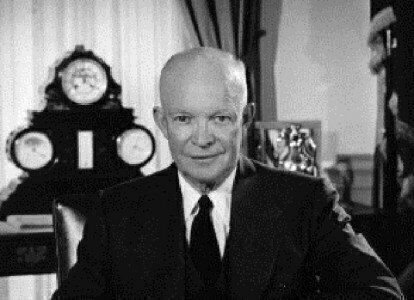Dwight Eisenhower was a rarity in American politics when he won the presidency in 1952 in his first campaign as a politician. So what else was unique about the 34th President?
 Born on October 14, 1890, Eisenhower came from humble roots, progressed steadily through the military, and assumed the top military and political posts in the United States. His success was hard-earned, and his popularity was constant as a public figure for decades.
Born on October 14, 1890, Eisenhower came from humble roots, progressed steadily through the military, and assumed the top military and political posts in the United States. His success was hard-earned, and his popularity was constant as a public figure for decades.
1. Eisenhower had Midwestern roots. Young Dwight Eisenhower grew up in Abilene, Kansas, where he excelled as an athlete. In 1911, he earned an appointment to West Point, where he played football and was an average student.
2. Jim Thorpe helped advance Eisenhower’s military career. Eisenhower was mostly focused on football at West Point until he literally ran into the legendary Jim Thorpe in a contest against Carlisle in 1912. Eisenhower developed a knee injury that ended his playing days.
3. George Patton was an early Eisenhower friend in the military. Both men started advocating for the use of tanks in modern warfare in the early 1920s. His superiors, who supported infantry warfare, weren’t happy with Ike.
4. Eisenhower excelled at academics after West Point. Named as a student at Fort Leavenworth’s Command and General Staff College, Eisenhower was first in his class of 245 officers, which made him a commodity in demand within Army leadership circles.
5. He became known as a planning and logistics expert. Eisenhower was General Douglas MacArthur’s chief of staff and then worked with Army chief of staff George Marshall. He became a natural choice to oversee the Allied invasion of western Europe.
6. Eisenhower opposed using nuclear weapons on Japan. He believed that a Japanese surrender was imminent in the summer of 1945. President Harry Truman, with access to other opinions and information, decided otherwise.
7. He was a reluctant presidential candidate. Eisenhower was asked by both parties to run for the White House in 1948 since he didn’t have a declared political party membership. Four years later, he chose to run as a Republican during the conflict with Korea.
8. Eisenhower was never seriously challenged in two presidential campaigns. In 1952 and 1956, he easily defeated Democratic challenger Adlai Stevenson. However, in 1956, the Democrats grabbed control of the House and Senate, as Ike’s popularity didn’t transfer to other Republicans.
9. He had a deep presidential legacy at home. President Eisenhower’s Administration saw the addition of Alaska and Hawaii as states, a massive build-out of the nation’s highway system, and the creation of NASA.
10. Eisenhower’s graduating class in 1915 had 59 future Generals. More than a third of his senior class went on to wear General’s stars, with Eisenhower and Omar Bradley achieving the rank of General of the Army.







